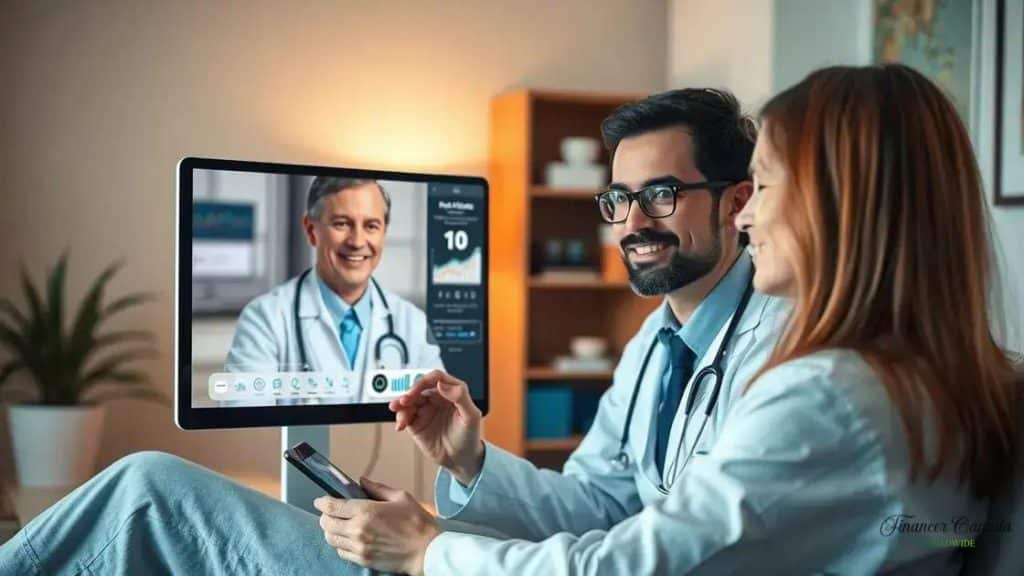Telemedicine’s role in transforming healthcare benefits

Telemedicine is transforming healthcare by providing accessible, efficient, and patient-centered services, utilizing technology to enhance the quality of care and reduce costs.
Telemedicine’s role in transforming healthcare benefits is game-changing, offering unprecedented access to medical care. Ever thought about how much time and stress it could save you? Let’s dive in!
Defining telemedicine and its importance
Understanding telemedicine is essential as it plays a crucial role in today’s healthcare system. This technology allows patients to connect with healthcare providers remotely, improving access to medical services, especially in underserved areas.
One significant aspect of telemedicine is its ability to reduce barriers for patients. Instead of traveling to a clinic, patients can consult with doctors from the comfort of their homes. This convenience can lead to more regular check-ups and better health outcomes.
Key benefits of telemedicine
Many people may wonder why telemedicine is gaining so much attention. Here are a few reasons:
- Improved access for remote and rural populations.
- Reduced waiting times for appointments.
- Lower transportation costs for patients.
- Greater flexibility in receiving care on-demand.
As technology advances, the importance of telemedicine continues to grow. It can integrate various services, such as mental health support and chronic disease management, into one platform. This integration enables a more comprehensive approach to patient care.
Additionally, telemedicine has adapted quickly to meet patient needs during emergencies, such as the COVID-19 pandemic. Many healthcare systems implemented virtual visits nearly overnight, showing how adaptable and necessary this form of healthcare is.
This method not only benefits patients but also healthcare providers who can reach more people and optimize their time. By utilizing telemedicine, healthcare systems can enhance their operational efficiency while maintaining high-quality care.
How telemedicine improves patient access

Telemedicine significantly enhances patient access to healthcare services. By removing geographical barriers, patients can receive care without the need to travel long distances. This is especially beneficial for individuals living in rural or underserved areas.
With the introduction of virtual consultations, patients can now book appointments via their smartphones or computers. This flexibility allows for timely care, which is crucial for managing chronic diseases or urgent health issues.
Key ways telemedicine boosts access
There are several reasons why telemedicine plays a vital role in improving access to healthcare:
- Convenience of consultations from home, saving time and cost.
- Ability to reach specialists who may not be available locally.
- Increased appointment availability, reducing waiting times.
- Access to a wider range of healthcare services, including mental health support.
Furthermore, telemedicine caters to those with mobility issues or transportation difficulties. For elderly patients or those with disabilities, accessing traditional medical facilities can be a challenge. With telehealth solutions, healthcare becomes more inclusive.
Patients can also benefit from improved continuity of care. Follow-up appointments are easier to schedule, allowing physicians to monitor their patients more effectively. Regular check-ins can help in early detection and management of health complications.
As telemedicine continues to evolve, it remains an essential tool for enhancing healthcare access. Technology integration makes it easier for patients to receive advice, prescriptions, and follow-up care, all from the comfort of their homes.
The cost benefits of telehealth solutions
The financial savings associated with telehealth solutions are significant. Patients and providers alike can experience reduced costs, which make healthcare more affordable for everyone. With telemedicine, patients save on travel expenses and time lost due to commuting.
For healthcare providers, telehealth can lead to increased efficiency. Facilities can serve more patients in less time, allowing doctors to maximize their schedules. This efficiency helps reduce overhead costs and can translate to lower fees for patients.
Understanding the financial benefits
Several key advantages highlight why telehealth is more cost-effective:
- Lower operational costs for clinics that offer virtual visits.
- Reduced no-show rates, as patients can attend appointments from home.
- Streamlined processes, which cut down administrative costs.
- Insurance companies are increasingly covering virtual visits, making them an affordable choice.
Beyond direct costs, telehealth solutions can also lead to better health outcomes, which is another way to save money long-term. Patients who receive timely care can avoid more serious health issues in the future, leading to lower healthcare costs overall.
In addition, educational programs offered through telehealth can empower patients with knowledge about managing chronic conditions. This can prevent costly hospital visits or emergency care, which further enhances savings for both parties.
As the healthcare landscape evolves, the adoption of telehealth solutions is expected to rise, promising even greater cost benefits. The combination of accessibility, efficiency, and affordability makes it a smart choice for modern healthcare.
Enhancing patient experience through technology

Technology plays a key role in enhancing patient experience in healthcare. Innovations such as telehealth platforms, patient portals, and mobile health apps provide easier access to information and care. Patients can now engage with their healthcare providers more actively than ever.
With the help of telemedicine, patients can have virtual consultations without the stress of traveling to a clinic. This not only saves time but also allows for more comfortable interactions. The ease of using technology significantly improves how patients perceive their healthcare experience.
Key tools improving patient experience
Several tools have emerged to improve patient care:
- Patient portals, where individuals can access their medical records, lab results, and treatment plans.
- Mobile applications that remind patients about appointments and medication schedules.
- Virtual waiting rooms that reduce time spent waiting for in-person visits.
- Online chat features for quick questions and support, enhancing communication.
These advancements help make healthcare more personalized and efficient. When patients feel empowered and informed, their overall experience improves dramatically. They can take charge of their health, making appointments and following treatment plans more manageable.
Moreover, technology allows for real-time feedback. Healthcare providers can gather information from patients and make adjustments quickly. This immediate response can enhance the quality of care significantly. It fosters a more collaborative environment between patients and providers.
As healthcare continues to evolve, the focus on enhancing patient experience through technology will likely grow, making care more accessible and satisfactory for everyone involved.
Future trends in telemedicine and healthcare
The future of telemedicine is bright, with several trends set to shape healthcare in the coming years. As technology continues to evolve, so do the possibilities for enhancing patient care and access to medical services.
One of the significant trends is the integration of artificial intelligence (AI) into telehealth platforms. AI can help analyze patient data, predict health issues, and even assist in diagnostics. This technology allows healthcare providers to offer more personalized and timely care.
Emerging technologies in telemedicine
Several key technologies are expected to influence the future of telemedicine:
- Wearable health devices that monitor vital signs in real time, sending data directly to healthcare professionals.
- Increased use of virtual reality (VR) for medical training and patient education.
- Improved data security measures to protect patient information during virtual consultations.
- Enhanced connectivity through 5G networks, allowing for more reliable and faster telehealth services.
Furthermore, there is a growing emphasis on patient-centered care through technology. Patients are becoming more involved in their health management, using apps and telehealth tools to monitor their conditions. This shift encourages a more collaborative relationship between patients and healthcare providers.
Additionally, regulatory changes are paving the way for broader acceptance of telemedicine practices. As policies adapt to the digital landscape, reimbursement for telehealth services is likely to improve, making it a viable option for many more patients.
Overall, the future trends in telemedicine indicate a more connected, efficient, and patient-friendly healthcare system, making quality care accessible to everyone.
In conclusion, telemedicine is transforming healthcare by making services more accessible, efficient, and patient-centered. With advancements in technology, patients are empowered to take charge of their health through virtual consultations and easy access to medical information. As we look to the future, the integration of new tools and practices is set to enhance the quality of care further. Telemedicine not only helps reduce costs but also builds stronger connections between patients and providers, leading to better health outcomes all around.
FAQ – Frequently Asked Questions about Telemedicine
What is telemedicine?
Telemedicine is a method of providing healthcare services remotely using technology, allowing patients to consult with healthcare providers from their homes.
How does telemedicine improve patient access to healthcare?
It removes geographical barriers, enabling patients in remote areas to connect with healthcare providers easily and conveniently.
What technologies are commonly used in telemedicine?
Common technologies include video conferencing tools, patient portals, mobile health apps, and wearable health devices.
What benefits does telemedicine offer for healthcare costs?
Telemedicine can reduce costs related to travel, time off work, and even operational costs for healthcare providers, ultimately making healthcare more affordable.





